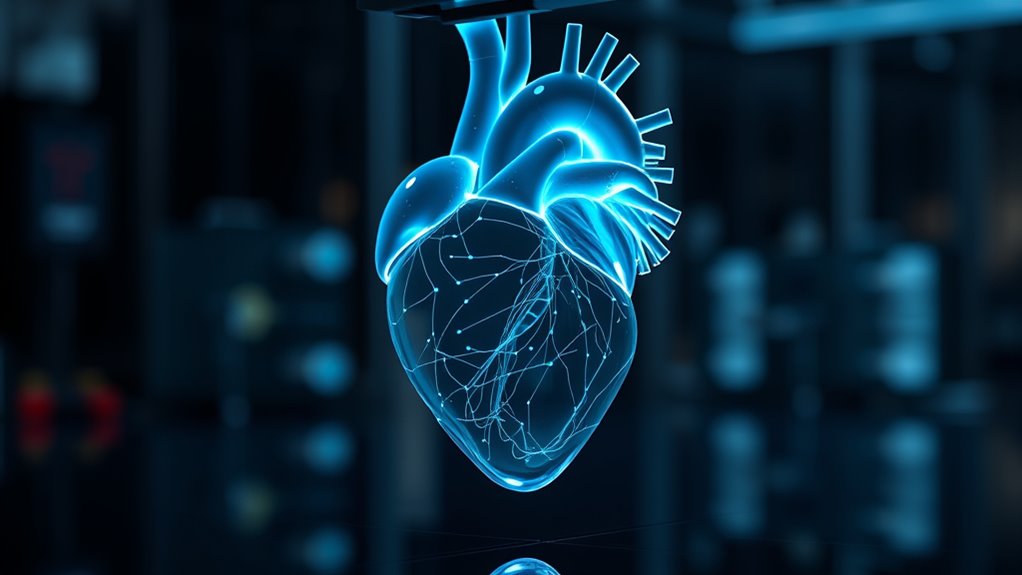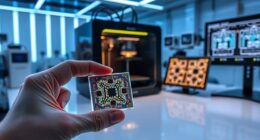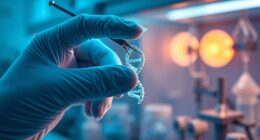Digital twin technology creates personalized virtual models of your organs, allowing you to test treatments and procedures risk-free before applying them in real life. These models continuously update with your health data, helping doctors predict disease progression, optimize therapies, and plan surgeries with greater safety and precision. By simulating responses to different interventions, digital twins minimize risks and improve outcomes. Keep exploring to discover how this innovative technology could transform healthcare for you.
Key Takeaways
- Digital twins create personalized virtual models of organs for safe, risk-free testing of treatments and procedures.
- They enable real-time simulation of disease progression and response to therapies, improving diagnosis and management.
- Virtual testing on digital twins helps optimize treatment plans without exposing patients to risks.
- These models support surgical practice, intervention planning, and drug testing in a controlled, virtual environment.
- Utilizing digital twins accelerates research, reduces costs, and enhances precision in medical testing and treatment.

Imagine having a virtual replica of your organs that updates in real time, allowing you to test treatments and interventions without any risk. This is the promise of digital twins in healthcare—a cutting-edge technology that creates personalized virtual models of your organs or physiological systems. These digital twins are not static; they continuously integrate data from your clinical records, lab tests, imaging scans, and wearable devices. By doing so, they mirror your unique biology, offering a dynamic, patient-specific representation that evolves with your health status. Instead of relying solely on generic models or invasive procedures, doctors can use these digital twins to better understand your condition and tailor treatments precisely to your needs.
Digital twins offer real-time, personalized virtual models to enhance diagnosis and treatment in healthcare.
The core idea behind medical digital twins is to move beyond traditional, reactive healthcare. Instead of waiting for symptoms to worsen, you can benefit from early diagnosis and proactive management. For instance, a digital twin of your heart, known as a cardiac digital twin, combines imaging data, blood flow measurements, and your medical history to simulate how your heart functions. This allows your healthcare team to test different treatment options in a virtual environment before applying them in real life. Surgeons, for example, can practice complex procedures on your digital twin, refining their approach and reducing risks during actual surgery. This risk-free testing enhances precision and minimizes complications, making interventions safer and more effective.
Digital twins also serve as powerful tools for predicting disease progression. By analyzing ongoing data, these models can forecast how your condition might evolve, enabling earlier intervention and more personalized treatment plans. They can simulate how your body responds to various drugs, helping doctors find the *best* dosage while minimizing side effects. This capability is especially valuable for managing chronic conditions like heart or lung disease, or rare disorders where traditional trial-and-error approaches are less effective. Additionally, digital twins open new possibilities for virtual clinical trials, drastically reducing costs and time associated with drug development. They identify promising therapies for real-world testing, streamlining the journey from research to treatment.
Compared to conventional methods, digital twins can reduce your exposure to unnecessary tests, imaging, and radiation. They accelerate diagnosis, treatment planning, and research by providing a virtual testing ground that’s both low-cost and rapid. This technology also enhances healthcare equity by making advanced modeling accessible even in resource-limited settings, where specialist expertise may be scarce. The integration of advanced computational techniques enables these models to process vast amounts of data efficiently. Moreover, ongoing research into data privacy and security is crucial to address concerns about sensitive health information. However, creating and maintaining these digital models requires integrating diverse data sources, employing advanced computing, and addressing challenges like data privacy, noise, and model validation. Despite these hurdles, the potential benefits of digital twins for personalized, risk-free treatment are transforming modern medicine into a more precise, proactive, and patient-centered field.
Frequently Asked Questions
How Accurate Are Digital Twins Compared to Real Organs?
You might wonder how accurate digital twins are compared to real organs. Studies show they can predict risks with 100% effectiveness in specific cases, like brain tissue loss or liver failure. They use real-time data to improve precision, but challenges like data quality and sensor noise remain. Overall, digital twins offer high fidelity, making them valuable tools for personalized, risk-free testing and treatment planning.
What Are the Ethical Considerations in Creating Organ Digital Twins?
When creating organ digital twins, you need to contemplate privacy and data protection, ensuring sensitive health info is secure and transparent. Fairness matters too—making sure everyone has equal access and isn’t excluded due to cost. Respect patient autonomy by obtaining informed consent and protecting their control over data. Finally, you must establish clear accountability, transparency, and ethical guidelines to prevent misuse, bias, or harm, ensuring the technology benefits all fairly and responsibly.
How Is Patient Privacy Protected During Digital Twin Development?
You might think your privacy is at risk when developing digital twins, but safeguards demonstrate otherwise. You control access via smart contracts, giving you real-time permissions and the ability to revoke them anytime. Data is encrypted, pseudonymized, and stored securely, adhering to strict laws like GDPR and HIPAA. Continuous monitoring and ethical oversight ensure your sensitive health info stays private, making digital twin development both innovative and trustworthy.
What Medical Conditions Can Digital Twins Effectively Simulate?
You can see that digital twins effectively simulate a wide range of medical conditions. They help predict heart issues like heart failure, arrhythmias, and coronary artery disease, as well as respiratory problems such as COPD and asthma. They also model metabolic disorders like diabetes, neurological conditions like stroke and epilepsy, and musculoskeletal issues including orthopedic injuries. These simulations enable personalized treatment planning and early intervention, improving overall patient care.
How Cost-Effective Is Implementing Digital Twin Technology in Healthcare?
Think of implementing digital twin tech like building a high-tech GPS for healthcare—initial costs can be steep, but the long-term navigation saves time and resources. You reduce operational costs by 15% and cut claims processing times by 30%. While upfront investments in hardware and software are significant, the efficiency gains, predictive analytics, and capacity planning make digital twins a cost-effective investment for high-stakes systems, delivering substantial ROI over time.
Conclusion
Imagine holding a replica of your heart in your hands, testing different treatments without any risk. Digital twins make this possible, allowing you to explore options safely and precisely. Just like a pilot uses a flight simulator to perfect their skills, you can now experiment with your health in a virtual world. With these innovations, you’re not just imagining better care—you’re living it. The future of medicine is personalized, safe, and within your reach.









